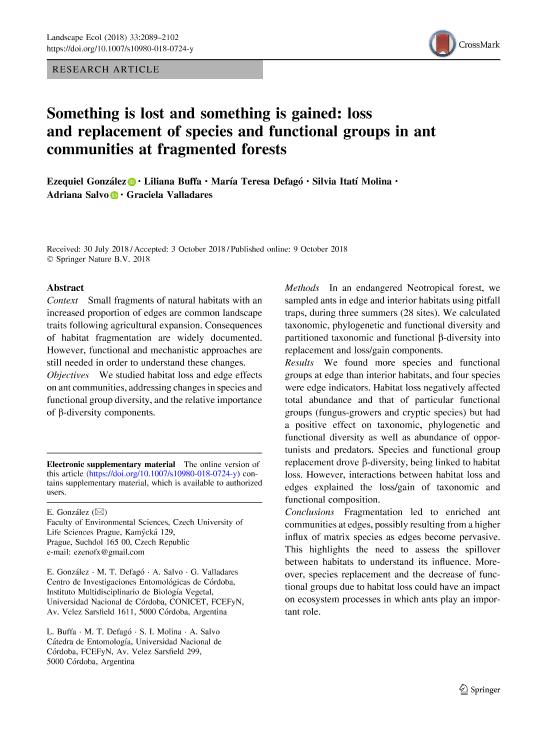Mostrar el registro sencillo del ítem
dc.contributor.author
González, Ezequiel

dc.contributor.author
Buffa, Liliana M.

dc.contributor.author
Defagó, María Teresa

dc.contributor.author
Molina, Silvia Itatí

dc.contributor.author
Salvo, Silvia Adriana

dc.contributor.author
Valladares, Graciela Rosa

dc.date.available
2019-11-04T18:14:19Z
dc.date.issued
2018-12
dc.identifier.citation
González, Ezequiel; Buffa, Liliana M.; Defagó, María Teresa; Molina, Silvia Itatí; Salvo, Silvia Adriana; et al.; Something is lost and something is gained: loss and replacement of species and functional groups in ant communities at fragmented forests; Springer; Landscape Ecology; 33; 12; 12-2018; 2089-2102
dc.identifier.issn
0921-2973
dc.identifier.uri
http://hdl.handle.net/11336/87938
dc.description.abstract
Small fragments of natural habitats with an increased proportion of edges are common landscape traits following agricultural expansion. Consequences of habitat fragmentation are widely documented. However, functional and mechanistic approaches are still needed in order to understand these changes. Objectives: We studied habitat loss and edge effects on ant communities, addressing changes in species and functional group diversity, and the relative importance of β-diversity components. Methods: In an endangered Neotropical forest, we sampled ants in edge and interior habitats using pitfall traps, during three summers (28 sites). We calculated taxonomic, phylogenetic and functional diversity and partitioned taxonomic and functional β-diversity into replacement and loss/gain components. Results: We found more species and functional groups at edge than interior habitats, and four species were edge indicators. Habitat loss negatively affected total abundance and that of particular functional groups (fungus-growers and cryptic species) but had a positive effect on taxonomic, phylogenetic and functional diversity as well as abundance of opportunists and predators. Species and functional group replacement drove β-diversity, being linked to habitat loss. However, interactions between habitat loss and edges explained the loss/gain of taxonomic and functional composition. Conclusions: Fragmentation led to enriched ant communities at edges, possibly resulting from a higher influx of matrix species as edges become pervasive. This highlights the need to assess the spillover between habitats to understand its influence. Moreover, species replacement and the decrease of functional groups due to habitat loss could have an impact on ecosystem processes in which ants play an important role.
dc.format
application/pdf
dc.language.iso
eng
dc.publisher
Springer

dc.rights
info:eu-repo/semantics/openAccess
dc.rights
Atribución-NoComercial-CompartirIgual 2.5 Argentina (CC BY-NC-SA 2.5 AR)
dc.rights.uri
https://creativecommons.org/licenses/by-nc-sa/2.5/ar/
dc.subject
ANTS
dc.subject
CHACO SERRANO
dc.subject
EDGE EFFECTS
dc.subject
FUNCTIONAL GROUPS
dc.subject
HABITAT LOSS
dc.subject
Β-DIVERSITY COMPONENTS
dc.subject.classification
Ecología

dc.subject.classification
Ciencias Biológicas

dc.subject.classification
CIENCIAS NATURALES Y EXACTAS

dc.title
Something is lost and something is gained: loss and replacement of species and functional groups in ant communities at fragmented forests
dc.type
info:eu-repo/semantics/article
dc.type
info:ar-repo/semantics/artículo
dc.type
info:eu-repo/semantics/publishedVersion
dc.date.updated
2019-10-24T18:18:59Z
dc.identifier.eissn
1572-9761
dc.journal.volume
33
dc.journal.number
12
dc.journal.pagination
2089-2102
dc.journal.pais
Alemania

dc.description.fil
Fil: González, Ezequiel. Consejo Nacional de Investigaciones Científicas y Técnicas. Centro Científico Tecnológico Conicet - Córdoba. Instituto Multidisciplinario de Biología Vegetal. Universidad Nacional de Córdoba. Facultad de Ciencias Exactas Físicas y Naturales. Instituto Multidisciplinario de Biología Vegetal; Argentina
dc.description.fil
Fil: Buffa, Liliana M.. Czech University Of Life Sciences Prague;
dc.description.fil
Fil: Defagó, María Teresa. Consejo Nacional de Investigaciones Científicas y Técnicas. Centro Científico Tecnológico Conicet - Córdoba. Instituto Multidisciplinario de Biología Vegetal. Universidad Nacional de Córdoba. Facultad de Ciencias Exactas Físicas y Naturales. Instituto Multidisciplinario de Biología Vegetal; Argentina. Universidad Nacional de Córdoba; Argentina
dc.description.fil
Fil: Molina, Silvia Itatí. Consejo Nacional de Investigaciones Científicas y Técnicas. Centro Científico Tecnológico Conicet - Córdoba. Instituto Multidisciplinario de Biología Vegetal. Universidad Nacional de Córdoba. Facultad de Ciencias Exactas Físicas y Naturales. Instituto Multidisciplinario de Biología Vegetal; Argentina
dc.description.fil
Fil: Salvo, Silvia Adriana. Consejo Nacional de Investigaciones Científicas y Técnicas. Centro Científico Tecnológico Conicet - Córdoba. Instituto Multidisciplinario de Biología Vegetal. Universidad Nacional de Córdoba. Facultad de Ciencias Exactas Físicas y Naturales. Instituto Multidisciplinario de Biología Vegetal; Argentina
dc.description.fil
Fil: Valladares, Graciela Rosa. Consejo Nacional de Investigaciones Científicas y Técnicas. Centro Científico Tecnológico Conicet - Córdoba. Instituto Multidisciplinario de Biología Vegetal. Universidad Nacional de Córdoba. Facultad de Ciencias Exactas Físicas y Naturales. Instituto Multidisciplinario de Biología Vegetal; Argentina
dc.journal.title
Landscape Ecology

dc.relation.alternativeid
info:eu-repo/semantics/altIdentifier/url/https://link.springer.com/article/10.1007/s10980-018-0724-y
dc.relation.alternativeid
info:eu-repo/semantics/altIdentifier/doi/https://doi.org/10.1007/s10980-018-0724-y
Archivos asociados
